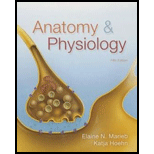
Concept explainers
What distinguishes the innate defense system from the adaptive defense system?
To review:
The first line of defense against disease.
Introduction:
The immune system is aptly defined as the defense system of the body. As it protects the body from most infectious microorganisms, cancer cells, and transplanted organs and grafts. Immune system defends by two ways - directly (by cell attack) and indirectly (by releasing chemicals and protective antibody molecules).
Explanation of Solution
Surface barriers such as skin and intact mucous membranes prevent entry of pathogens in the body and form the first line of defense against disease. The epithelial membrane is a formidable physical barrier to most of the organisms. Keratin which is a type of protein is found to be resistant mostly to weak acids and bases as well as to bacterial enzymes and toxins. The lining of mucous membranes in the form of intact mucosae provides mechanical barriers within the body. As mucous membrane line all body cavities that open to the exterior end such as the reproductive, digestive, respiratory, and urinary tracts. The significance of the first line of the defense system is to keep the invaders out of the body.
Besides being serving as physical barriers, skin and mucous membranes also produce a variety of protective chemicals in the following forms:
Defensins – A small amount of broad-spectrum antimicrobial peptides secreted through mucous membranes and skin are called defensins. In response to inflammation when surface barriers are breached, defensin output increases at a high rate. Defensins also help in controlling bacterial and fungal colonization in the exposed areas by causing disruption of microbial membranes.
Acid – The acidity (acid mantle) of skin, stomach, and vaginal secretions inhibits the growth of the bacterial growth.
Mucin – Mucin when dissolved in water, it forms a thick, sticky mucus which lines the respiratory and digestive passageways. As mucus traps microorganisms. In the similar manner, mucin in watery saliva traps microorganisms and washes them out of the mouth into the stomach where they are digested. Mucus-coated hairs inside the nose trap inhaled particles and cilia present on the mucosa of the upper respiratory tract help to move dust and bacteria laden mucus towards the mouth, preventing it from entering the lower respiratory tract and its passages.
Enzymes – Lysozyme (present in saliva), respiratory mucus, and lacrimal fluid of the eye – it destroys the bacteria. Protein-digesting enzymes in the stomach also responsible for destroying many microorganisms.
Other chemicals – Some lipids in sebum and dermcidin in eccrine sweat cause toxicity in bacteria.
Therefore, it can be concluded that the primary defense mechanism against various infectious disease is the surface barriers, which prevent pathogens from entering the body. These surface barriers include the mucous membranes andintact skin. They release the chemical secretions that are responsible for restricting the growth of microbes on their surfaces. Therefore, if pathogens cannot enter the body of the host, they cannot disrupt normal the physiological functions and cause disease.
Want to see more full solutions like this?
Chapter 20 Solutions
Anatomy and Physiology - With CD and Atlas and Lab. Man.
- Distinguish between nonspecific defense and adaptive immunity?arrow_forwardWhat is the difference between non-specific and specific defenses? Contrast the two methods of defense, why are they important ?arrow_forwardExplain the difference between innate (nonspecific) defenses and adaptive (specific) defenses.arrow_forward
- what role does the immune system play in preventing disease? give specific examples for the first, second and third lines of defense.arrow_forwardWhy are innate immunity and inflammation described as “nonspecific”?arrow_forwardWhat are some examples of innate defense mechanisms that are chemical in nature? What is complement?arrow_forward
 Human Biology (MindTap Course List)BiologyISBN:9781305112100Author:Cecie Starr, Beverly McMillanPublisher:Cengage Learning
Human Biology (MindTap Course List)BiologyISBN:9781305112100Author:Cecie Starr, Beverly McMillanPublisher:Cengage Learning

